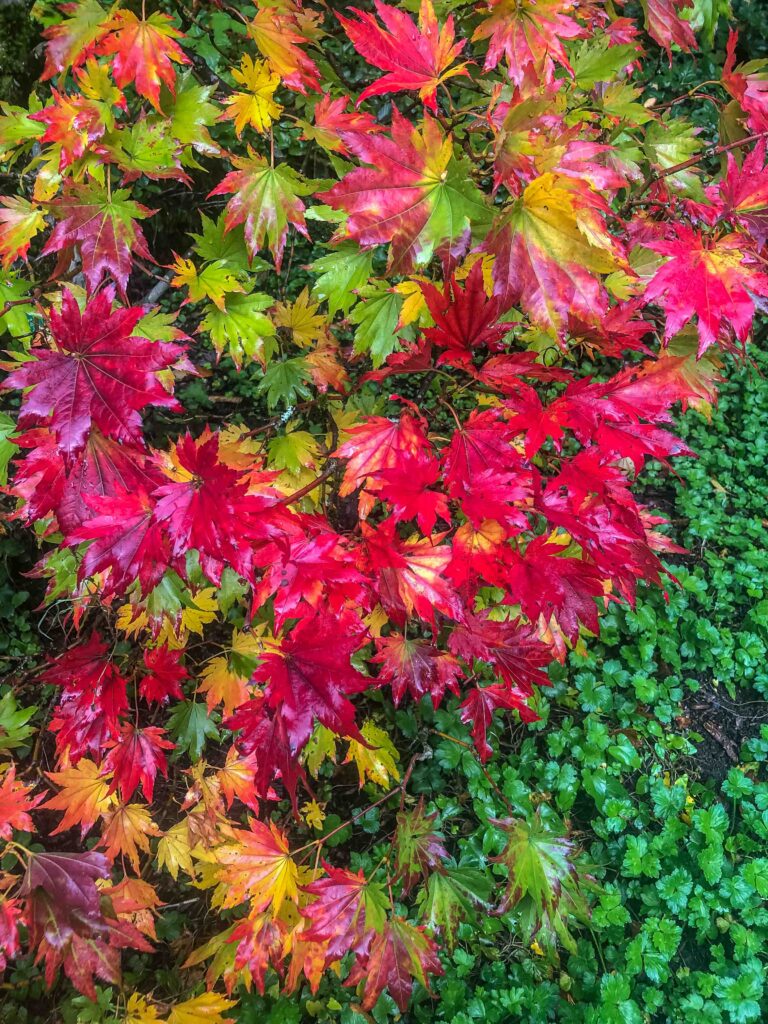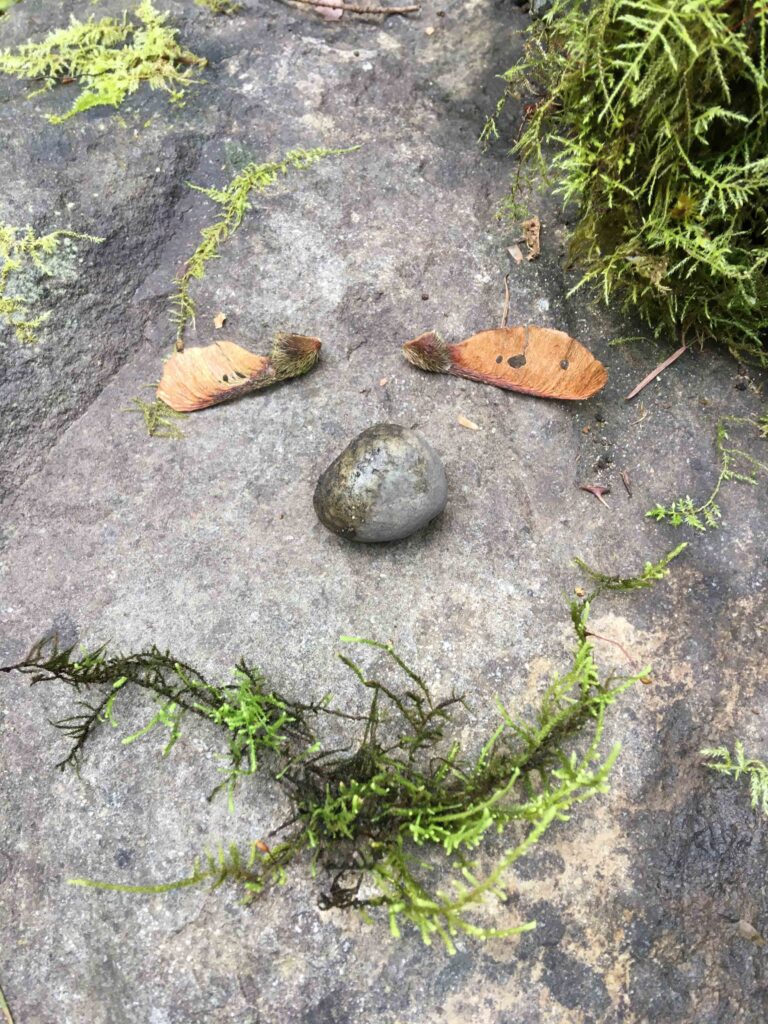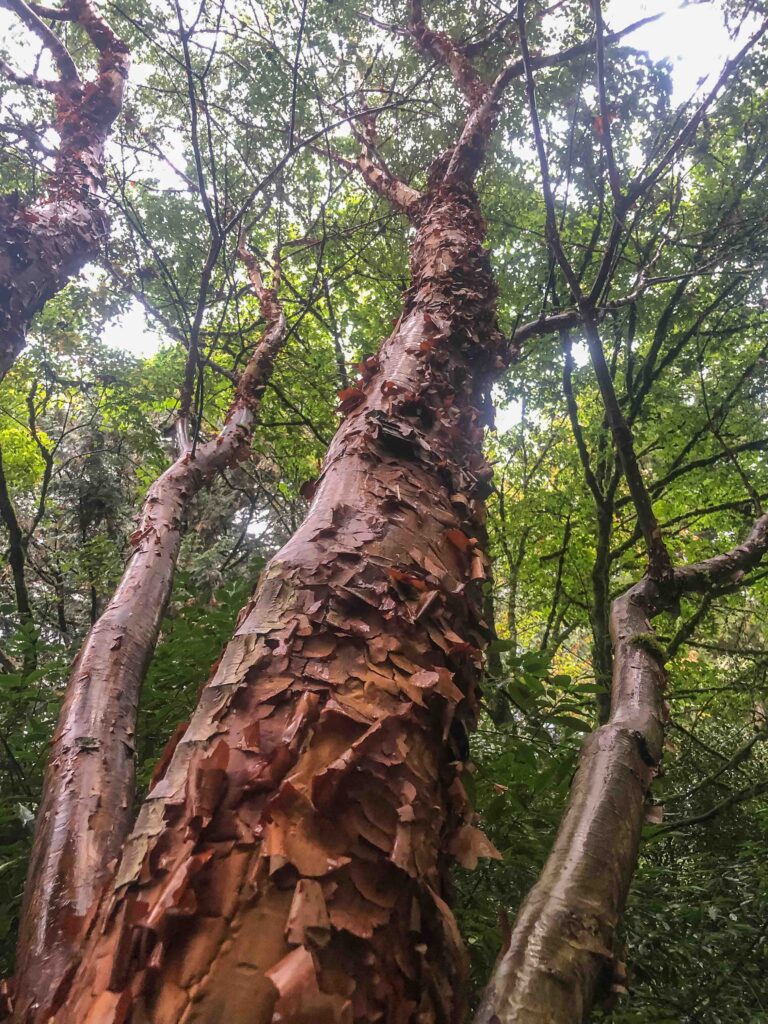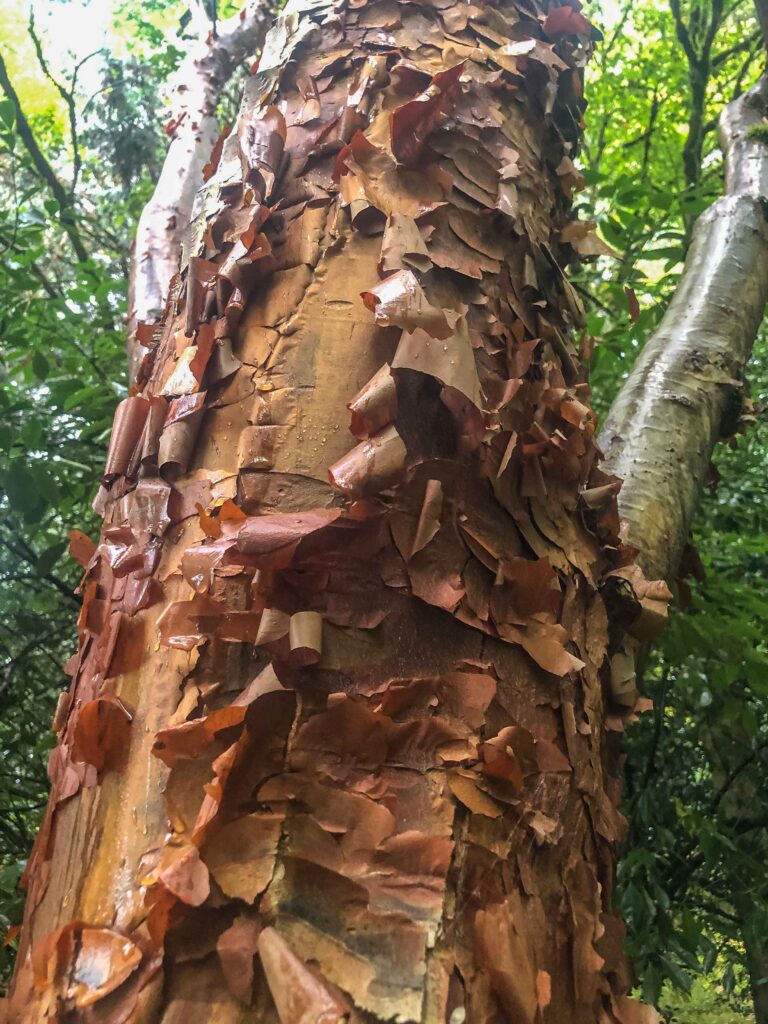Before I share my recent experience with forest bathing, I wish to extend deep gratitude to Chloe Lee, affiliated with Cascadia Forest Therapy. She first introduced me to the practice in March 2021. Chloe has a unique and deeply personal way of extending “Invitations” to enjoy the forest.
Last Tuesday, she invited me to join her on a guided walk in the Arboretum. During our two hours, she asked me several questions about my own practice which I thought would make a good introductory blog post. Any errors herein are mine alone.

What Is Forest Bathing?
Put most simply, forest bathing, or shinrin-yoku, is the Japanese practice of self-care and mindfulness that involves opening your senses to all the forest has to offer, from noticing movement, seeking tiny objects, experiencing colors in new ways, or finding a place to sit and absorb whatever Mother Nature offers.
If after reading this post you’re interested in learning more, please visit Cascadia Forest Therapy’s article on a “Typical Forest Bathing Session” or scroll down for some wonderful resources I found on my shelf.

The Beginnings Of My Journey
In March 2021, I needed helpful ways to handle stress rather than sinking into addictive tendencies. Chloe introduced me to the calm, centering practice of forest bathing. During our walk this week, she asked me to share an early forest bathing memory.
I recounted my first time in Boeing Creek Park, a place I’ve returned to many times since. At her invitation to find something that “spoke” to me in some way, I crept up to the biggest Douglas fir in the area. I caressed the ribbed bark, circled around the trunk examining woodpecker holes and moss covering it, and looked up as the tree sighed on the breeze.

Be-a-Tree
Assigning the tree a human name didn’t feel right. I intuitively thought of it as female, but I admit I don’t know whether trees can even be male or female. So I refer to the tree simply as “Be-a-tree.” (Beatrice?) I gave Be-a-tree a hug, stared up into its high and mighty branches dwarfing all those in its presence, and felt deeply connected to a tree in a way I never had before. Almost like the tree was a grandparent. Or great-grandparent.
Am I a tree hugger? That particular one, yes.

Every time I return to the park, I include a short visit to Be-a-tree. Oh, the many fascinating years it has experienced. And it will probably be standing long after I move on. Appreciating nature’s longevity and healing powers helps put things into proper perspective. It’s hard to be depressed or manic while surrounded by trees.
Have you ever connected with a tree? If you are interested in learning more about the hidden lives of trees, check out Peter Wohlleben’s book.
Sit Spot
Chloe extended another invitation in a grove where a barred owl hooted a greeting. She suggested we find a spot to lean up against a tree and absorb whatever Mother Nature wanted to reveal. This time I found a Madrone with peeling bark. Since I seldom visit the Arboretum, and probably couldn’t locate this one again, I did not feel a need to name it. However, I did notice the lovely, thin, tissue-paper bark.
In our tea circle, I shared that Mother Nature had wrapped up the tree, almost as a present. Have I mentioned that I love trees?

Integrating Practice with an Urban Lifestyle
A question we discussed in a group and in smaller groups was how to include a forest bathing practice in an urban setting. My own practice looks like this:
- Daily walks (3-4) outdoors with my dog, rain or shine
- Daily grounding (earthing) in my backyard, 30 minutes
- Weekly hikes with my dog
- Birding seasonally, sometimes monthly
- Forest bathing as the opportunity arises, no set frequency but more often in spring
- Vacations 2x/year to wildlife destinations for bird and animal photography
- My Active Ajax Adventures Rambles and OcTraPiMo projects, both outdoors-based projects

As you can see, even living in an urban setting like Seattle, I have carved out regular practices that take me out in nature to help me stay grounded, connected, and less stressed. You can, too, by making it a priority and finding ways that work for you.
Developing Your Practice
If you are interested in trying forest bathing for yourself, you can embark on a guided trip to see what the invitations and practice look, feel, and sound like.
Once you have had a taste for it, plan a few visits to your nearest greenspace, preferably a place with trees. Go alone, without any set objective of time or distance. Your goal is simply to BE and FEEL. Motion can come later once you tap into emotions.
Use all five senses. Can you find ten different sights that appeal to your eyes? a certain color? something bigger than a bicycle, smaller than a penny? What do you hear? When you walk, how do you feel? how does it feel to rub your feet along the surface or skim the top with your hand? Are there distinct smells?

Perhaps the hardest sense to use during forest bathing is taste. I don’t advocate trying mushrooms, as I don’t know which might be poisonous, but when berries are ripe or apples are in season, go for it. We enjoyed 100% cacao and freshly brewed forest tea with cedar, cinnamon, and nettle Chloe picked during our hike.
Where Can I Learn More About Forest Bathing?
- Forest Bathing Retreat: Find Wholeness in the Company of Trees, by Hanna Fries
- Wild Calm: A Guided Journal, Finding Mindfulness in Forest Bathing by Joan Vorderbruggen
- The Joy of Forest Bathing by Melanie Choukas
- The Healing Nature Trail by Tamarack Song
- And just for fun, Forest Bathing with Your Dog by Nadine Mazzola

If you are interested in contacting Chloe Lee directly, here are her personals:
Instagram @chloe_jane_lee
Now go outside, find a tree to admire and learn about for the next five minutes, and tell it Chloe, Court, and Be-A-Tree sent you!


Super article. Yes I love forest bathing & I practice it every week.
I’ve never seen a madrone tree, an interesting tree.
I love BE-a-TREE.
Hey thanks for the comment Silvie-Marie. Madrones ARE fascinating. For more on them, here’s a cool little article on them: https://www.nps.gov/articles/pacific-madrone.htm#:~:text=Madrones%20occur%20natively%20in%20the,Northwest%20millions%20of%20years%20ago.
We have one in our front yard! Madrones are native to the Pacific Northwest from southern CA coastal ranges north into BC but what is so cool about them is their bark. They have leathery evergreen leaves, red bark which easily peels from a tan-orange trunk, whitish flowers, and bright clusters of reddish-orange berries.
Bathe on! And hug YOUR favorite tree today!